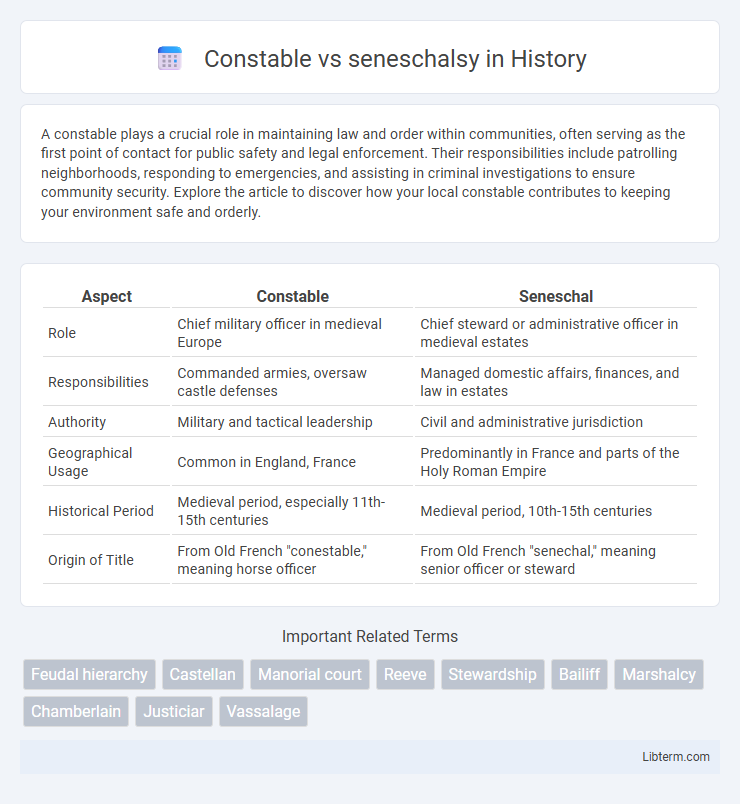A constable plays a crucial role in maintaining law and order within communities, often serving as the first point of contact for public safety and legal enforcement. Their responsibilities include patrolling neighborhoods, responding to emergencies, and assisting in criminal investigations to ensure community security. Explore the article to discover how your local constable contributes to keeping your environment safe and orderly.
Table of Comparison
| Aspect | Constable | Seneschal |
|---|---|---|
| Role | Chief military officer in medieval Europe | Chief steward or administrative officer in medieval estates |
| Responsibilities | Commanded armies, oversaw castle defenses | Managed domestic affairs, finances, and law in estates |
| Authority | Military and tactical leadership | Civil and administrative jurisdiction |
| Geographical Usage | Common in England, France | Predominantly in France and parts of the Holy Roman Empire |
| Historical Period | Medieval period, especially 11th-15th centuries | Medieval period, 10th-15th centuries |
| Origin of Title | From Old French "conestable," meaning horse officer | From Old French "senechal," meaning senior officer or steward |
Introduction to Medieval Offices: Constable vs Seneschal
The medieval offices of Constable and Seneschal represented distinct but crucial roles in feudal administration and military command. The Constable primarily oversaw the defense and organization of the lord's military forces, commanding the castle and knights during warfare. In contrast, the Seneschal managed domestic affairs, including the administration of estates, overseeing justice, and coordinating the operation of the household, ensuring the smooth governance of the lord's domain.
Historical Origins of the Constable and Seneschal
The constable originated in medieval Europe as a high-ranking officer responsible for the command of the cavalry and the management of a lord's military forces, stemming from the Latin term "comes stabuli," meaning "count of the stable." The seneschal, deriving from the Old Frankish term "seniscalcus," functioned as a steward or major-domo, overseeing domestic affairs and administration within a noble household or estate. Both roles evolved to encompass broader legal and judicial responsibilities, reflecting their integral positions in feudal governance and territorial administration during the Middle Ages.
Core Responsibilities of a Constable
Core responsibilities of a Constable include maintaining public order, enforcing laws, and ensuring community safety through regular patrols and crime prevention. Constables have authority to arrest suspects, conduct investigations, and provide assistance during emergencies. Their role often involves collaboration with other law enforcement agencies to uphold justice and protect citizens.
Key Duties of a Seneschal
A seneschal acted as the chief administrative officer in medieval estates, overseeing the management of household staff, organizing the lord's domestic affairs, and ensuring the smooth operation of day-to-day activities. Key duties included supervising servants, managing financial accounts, coordinating food and supplies, and maintaining order during feasts and legal proceedings. Unlike constables, whose responsibilities centered on military command and law enforcement, seneschals focused on efficient estate administration and internal governance.
Authority and Jurisdiction: Comparing Powers
Constables held local law enforcement authority with jurisdiction limited to maintaining peace, serving warrants, and executing court orders within their assigned precincts. Seneschals exercised broader administrative and judicial powers, often overseeing the management of estates or regions, including tax collection, civil dispute resolution, and enforcement of sovereign laws. The constable's authority was primarily operational and enforcement-based, while the seneschal wielded a more comprehensive jurisdiction spanning governance, legal adjudication, and fiscal responsibilities.
Constable vs Seneschal: Chain of Command
The constable held a crucial role in medieval military hierarchy, overseeing the army's organization, discipline, and battlefield command. The seneschal primarily managed domestic affairs and administration within a noble household or estate, with responsibilities often limited to civil jurisdiction. In the chain of command, the constable operated directly under the monarch or high-ranking noble in military matters, while the seneschal functioned as the principal steward, managing estates without direct military authority.
Geographic Variations in Roles
Constable roles in England typically involve local law enforcement duties within rural or small-town jurisdictions, whereas seneschals in medieval France held administrative and judicial authority over larger estates or regions, reflecting a feudal governance structure. Geographic variations highlight that constables operated under emerging centralized state systems focused on policing, while seneschals managed noble estates and royal courts, embodying decentralized territorial control. These distinctions underscore the evolution of public order roles influenced by regional legal traditions and political frameworks.
Influence on Medieval Society and Governance
Constables held military authority and oversaw law enforcement, significantly shaping medieval social order by ensuring security and justice within feudal domains. Seneschals managed administrative and financial affairs, influencing governance through the organization of estates and the supervision of domestic staff in noble households. Together, their roles created a balance between martial enforcement and civil administration, reinforcing the hierarchical structure of medieval society.
Evolution of the Positions Over Time
The roles of constable and seneschal evolved significantly from the medieval period to early modern times, reflecting shifts in governance and military organization. Constables transitioned from primarily military commanders responsible for the army's discipline to broader law enforcement and judiciary roles, while seneschals moved from overseeing domestic administration and justice in noble households to high-ranking officials managing regional courts and royal estates. This evolution highlights the increasing specialization and bureaucratization within feudal and royal administrations.
Legacy and Modern Equivalents
Constables historically served as local law enforcement officers responsible for maintaining order and executing court duties, while seneschals oversaw domestic and administrative affairs in feudal households and estates. The legacy of constables endures in modern police forces, embodying public safety and community policing roles, whereas seneschals' functions have evolved into contemporary estate managers and judicial officers in certain jurisdictions. Understanding these roles highlights the transformation from medieval governance structures to present-day legal and administrative systems.
Constable Infographic

 libterm.com
libterm.com